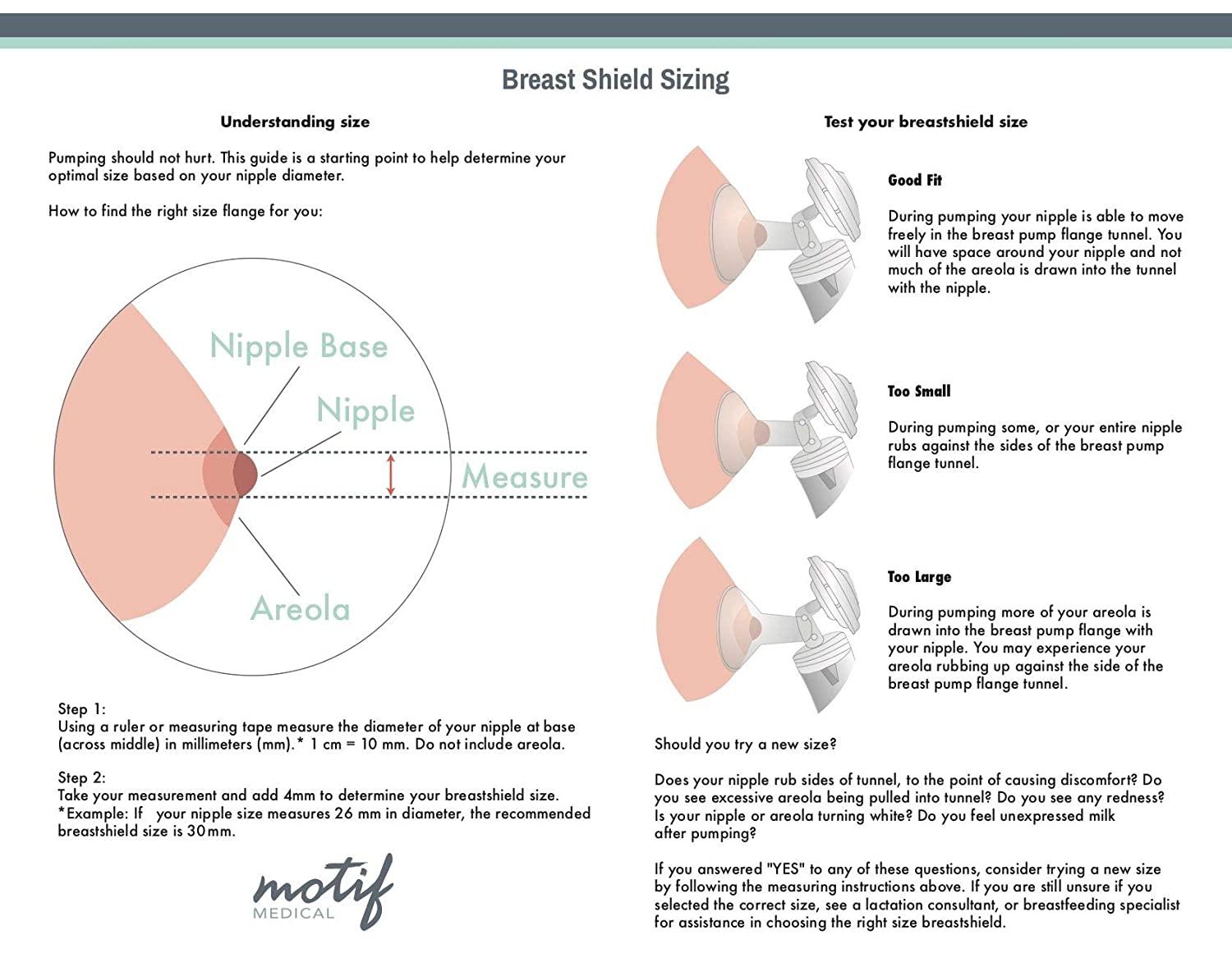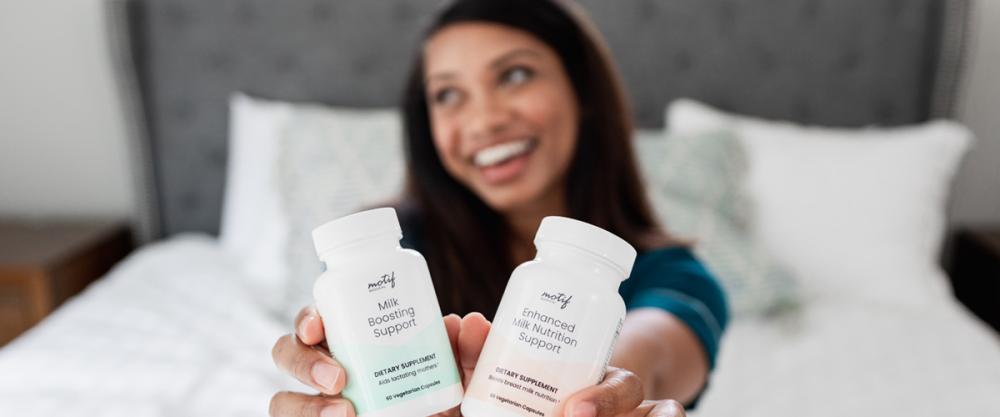Finding the right fit is always important – whether it’s for clothing, shoes, or your breast pump flange. One of the most common questions I get from breastfeeding moms is how to maximize breast milk output while pumping. But many of them don’t realize the answer has a lot to do with flange sizing. The correct flange size makes the pumping session both more comfortable and more efficient since it stimulates the breast more effectively.
The flange mimics a proper breastfeeding latch. Too large, and the areola gets compressed, causing the milk to get stuck prior to release, much like the kink in a water hose. Too small, and there’s too much friction on the nipple, causing blisters, soreness, and inadequate milk production.
It may seem overwhelming, (one more thing to learn!) especially for new moms. Let’s take a closer look at how to find the right size.
What is a Breast Pump Flange?
A breast pump flange (also called a breast shield) is the cone-shaped plastic cup that fits directly over your nipple to form a seal around the areola. Vacuum suction creates an effective seal gently draws the nipple into the funnel for milk extraction.
The wrong size flange could impact your milk flow and damage breast tissue. It can result in breast pumping pain, blocked milk ducts, swelling, and nipple damage. The right breast shield size allows you to pump comfortably and maximize the amount of milk you produce.
How to Place a Breast Pump Flange
When placing the flange, play close attention to how the nipple sits in the narrow tunnel. A proper fit has the nipple centered, without any contact with the rim. This allows the nipple to move freely and stretch as it’s drawn into the flange.
Since it's referred to as “breastfeeding” and not “nipple feeding,” the nipple is not the only part of the breast to consider. The areola is also important. The areola is the darkened area around the nipple. The primary function of the areola is to serve an easy-to-see bullseye for the baby to aim for when latching. It’s also a collector where all of the milk ducts and channels send the milk from storage.


The funnel of the flange mimics the lips of a baby, who will pull not only the nipple into their mouth, but also just a small amount of the areola. If none of the areola makes it into the mouth or the flange, there is inadequate stimulation to the breast and that may interfere with long-term milk supply and production. It may also affect comfort, as this could also lead to tightness around the nipple, which has a negative impact on milk production, too.
A comfortable fit means less physical stress on the breasts, which helps the body relax and respond well to oxytocin, the hormone responsible for releasing milk.
Finding The Correct Breast Pump Flange Size
Motif’s goal is to help mom have the most comfortable pumping journey possible. Our handy flange sizing chart helps you determine your best fit. Be sure to review each size option to choose the one that will fit best.
Flanges are sized in millimeters (mm). Again, it should be slightly larger than the nipple measurement to allow for movement. It’s also important to measure BOTH nipples, as just like in breast (and bra) size, symmetry is not always part of the equation.
To determine what size you need, you’ll need to know your nipple size. You can measure your nipple by taking a ruler or measuring tape to measure the diameter of your nipple (the horizontal width across it). Measure the nipple alone, do not include the areola which is the outer edge around your nipple. The measurement should be in millimeters (1 cm = 10mm).
Select your flange size based on your measurement.
- If you measured up to 17mm you’ll fit in a 21mm flange.
- If you measure up to 22mm use size 24mm.
- If you measured up to 23mm select size 27mm.
- If you measured up to 26mm use 30mm.
- If you measured up to 32 mm use size 36 mm.
A quick trick is to make the ASL sign for “I love you,” and compare the fingers for approximate nipple size comparison. The thumb 24-26 mm, the index 21-23mm, and the pinky 20 or smaller. Sizes needed would be 30, 27, and 24, respectively.


Once a size estimate is completed, try pumping. Observe the fit and movement to ensure you’ve found the right size flange.
How to Tell if Your Flange Is Too Small
If your breast pump flange is too small you may experience:
- Friction on the nipple as it is pulled against the sides of the tunnel
- Bruising or cracking at the base of the nipple
- Painful pinching, pulling, or squeezing of the nipple
- Clogged milk ducts
- White or discolored nipple after you pump
- Decreased milk production
How to Tell if Your Flange Is Too Big
If your breast pump flange is too big you may experience:
- All or a most of your areola being pulled into the flange and tunnel, causing pain
- The flange loses contact with the breast within the first few minutes
- Your breasts aren’t fully drained, leading to decreased output
- White or discolored areola
- Decreased milk production
You'll Know You Have the Right Breast Pump Shield If...
- Your nipple is in the center of the flange and moves freely into the tunnel of the breast pump for comfortable milk expression.
- Your breasts are fully drained and you can’t feel any areas that still contain milk, as this could indicate uneven breast milk extraction.
- You don’t experience nipple pain.
- Your nipple and areola do not turn white or become discolored, which could indicate the blood supply has been cut off.
“Find what is comfortable. Too much friction to the tissue, tightness, or painful sucking could indicate the incorrect size. The top of the nipple and its base should be the only part entering the flange tunnel.”
Ashley Georgakopoulos, Motif Medical Lactation Director (IBCLC)
When to Measure Your Nipples
Throughout pregnancy the breast tissue goes through changes. This includes the size of the breast, as well as the darkening of the areola. Another change would be the size of the nipples. While, for some, the change is subtle, it can still impact the initial fit of the flange. Women tend to retain fluid as the pregnancy progresses, as well as when fluids are administered.
The early part of the third trimester or 2-3 weeks postpartum is a great time frame to measure the nipple to get a good idea of what size the nipple will be for the majority of the times needed for pumping. A separate measurement may be needed if pumping and expressing milk is needed immediately postpartum.
Bonus Flange Size Tips
- If this is your first-time breast pumping, consult with a lactation consultant to assist with determining the flange fit according to nipple shape, areola density, and areola fullness.
- Measure both of your nipples in case they are different sizes. Some moms need two different flange sizes.
- Your flange size could change over time, especially after giving birth. Regularly measure your nipples to see if you need to change sizes.
Whether a new mom or a veteran, many moms need help with breastfeeding and pumping. An Internationally Board Certified Lactation Consultant (IBCLC) will have extensive training in helping with finding the perfect size flange, along with pumping techniques, storage, feedings, troubleshooting and more!


Information provided in blogs should not be used as a substitute for medical care or consultation.










